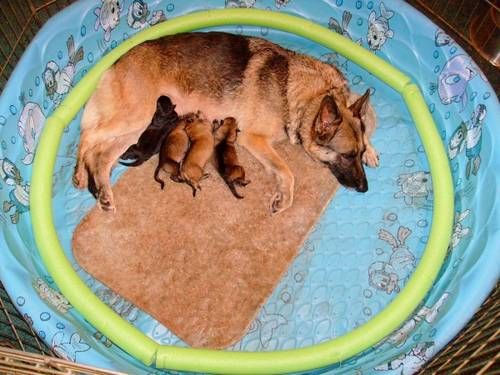Occasionally, C.A.R.E. will take in a pregnant dog, and we may choose to send her into a foster home to have her puppies. We will usually have the mother dog brought to a Vet Clinic to have x-rays done prior to placing her in foster care, so we can see how many puppies she is expecting and ensure that all of the puppies are birthed properly. If this is your first time caring for a pregnant mother dog, we will speak with you about your role during labor, but we also encourage you to do some reading and inform yourself as well.
Preparing for Puppies
You want the mother dog—s whelping to be as comfortable as possible for her, and as hassle-free as possible for you. The best way to do this is to set up a whelping box. Whelping boxes offer a safe, warm, comfortable, easily cleaned location for your foster dog to have her puppies. Ideally, set up the whelping box away from all other dogs and in a quieter area to give the mom privacy.
If you bring a mother dog home, C.A.R.E. will supply you with a whelping box (we sometimes use kiddie pools). Dogs look for warm, safe places to deliver their puppies. If you don—t introduce her to the whelping box beforehand, she might decide to deliver elsewhere—like your closet, so be sure to let her get accustomed to the whelping box prior to the birthing process.
You will want to assemble the necessary whelping supplies ahead of time, so that you have them on hand when your dog goes into labor.
Whelping Supply Checklist:
- Newspaper to line the whelping box during delivery for easy clean up
- Non-skid bath mats for bedding after whelping is done
- Dry, clean towels to clean the puppies
- Paper towels to help with clean up
- Thermometer to check your dog—s temperature before whelping
- Unwaxed dental floss to tie off the umbilical cords (if necessary)
- Clean scissors to cut the umbilical cords (if necessary)
- A heating pad or hot water bottle to keep the puppies warm (be careful of it not being too hot)
- Iodine to clean the puppies— abdomens after the cord is cut and dab on the end of the cut umbilical cord
- A baby scale in ounces
Keep these supplies in a clean, easy-to-access location. When the pregnant dog—s time approaches, watch out for the warning signs of labor in dogs. Pregnant mothers may stop eating a few days before whelping and may also start trying to build a “nestâ€â€”hopefully in the whelping box. Many pregnant dogs start to pant heavily, and her temperature will drop from a normal temperature (100-to-102.5 degrees Fahrenheit) to 99 degrees or even lower shortly before going into labor. Approximately 24 hours after this temperature drop, she will whelp, and you will be the proud foster of a new litter of puppies.
Whelping
Unlike humans, dogs generally give birth easily and do not require assistance. Your role is to assist when necessary. Each puppy is born enclosed in its placental membrane. In most cases, the mother tears this membrane off, sometimes eating it. If she does not, you will have to remove it, as puppies cannot survive for more than a few minutes before their supply of oxygen runs out.
The mother dog should also sever the umbilical cord as she cleans her pups. If she does not, it is up to you to snip the cord and tie it off with some unwaxed dental floss. You should wipe the abdomen of all of the puppies with iodine to prevent infection from entering through the umbilical cord. The cord should be tied and cut about 1-2 inches from the puppy.
You must also keep track of the number of placentas. A retained placenta can cause problems for the mother, so observe her carefully, and while you are at it, keep an eye on the pups to make sure they are all breathing normally and nursing.
Possible Dog Labor Complications
Sometimes during delivery, things go wrong. Most dogs deliver with ease, but it is crucial that fosters of expecting dogs know the warning signs of labor complications.
- Labor is uncomfortable. However, it should not cause your dog extreme pain. If your dog is exhibiting symptoms of severe discomfort, please contact the C.A.R.E. medical team using our Support Contacts page.
- If more than two hours pass in between the delivery of puppies, or if your dog experiences strong contractions that last more than 45 minutes without a birth, please contact the C.A.R.E. medical team using our Support Contacts page.
- Trembling, collapsing, or shivering are warning signs of serious complications that could put both the mother dog and the puppies at risk.
- It is normal for dogs to deliver a dark green or bloody fluid after the first puppy, but if this happens before the first puppy, please contact the C.A.R.E. medical team using our Support Contacts page.


